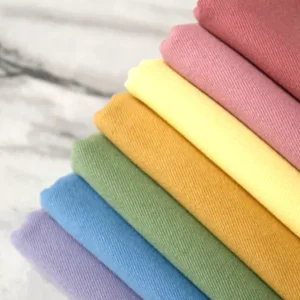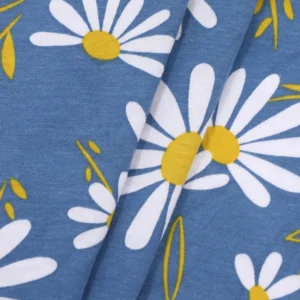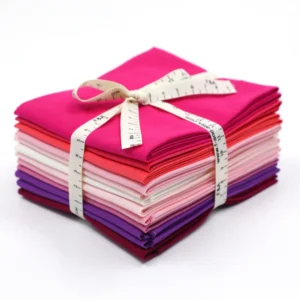When choosing fabrics, understanding the differences between blended fabrics and 100% cotton is crucial. Each offers unique properties that cater to diverse needs. This blog post explores the distinctions between these two fabric types, highlighting their composition, benefits, and typical applications.
We’ll delve into the characteristics that set blended fabrics apart from pure cotton, examining how fiber combinations enhance performance, durability, and comfort. By comparing their respective strengths and weaknesses, we’ll help you make informed decisions for your textile projects.
What Is Blended Fabric
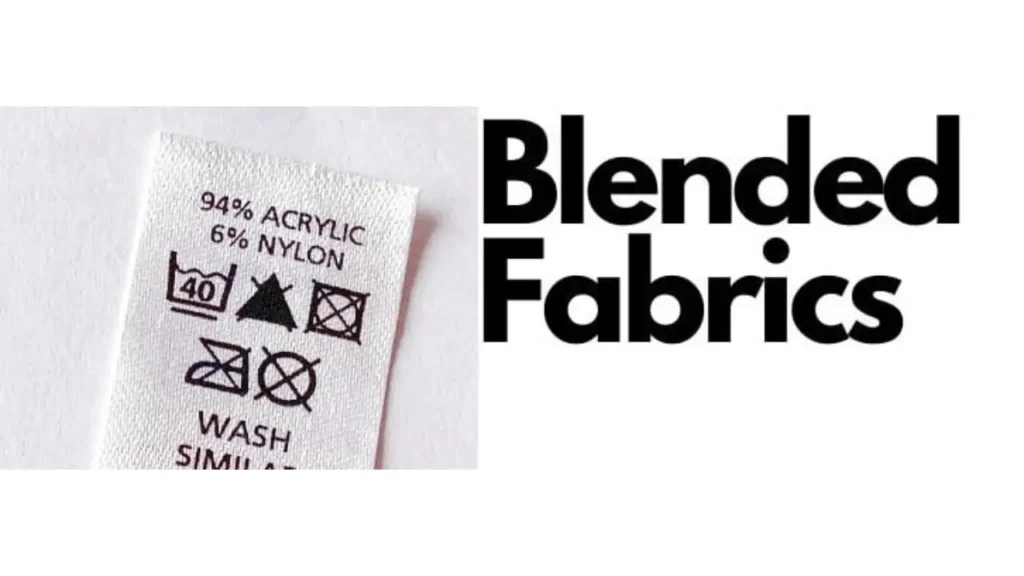
Blended fabric is a textile created by combining two or more different types of fibers during the yarn spinning process. This technique aims to leverage the desirable qualities of each fiber, resulting in a fabric that offers enhanced performance and aesthetics. By strategically combining fibers, manufacturers can address the limitations of individual materials and create textiles tailored to specific applications.
Common blends involve combinations of natural fibers like cotton, wool, or silk with synthetic fibers such as polyester, nylon, or rayon. The resulting fabric often exhibits improved durability, wrinkle resistance, and comfort compared to textiles made from a single fiber. This versatility makes blended fabrics a staple in various industries, including apparel, home textiles, and industrial applications.
What Is Cotton Fabric
Cotton fabric is a natural textile derived from the fibers of the cotton plant. These fibers are spun into yarn, which is then woven or knitted to create the fabric. Cotton is renowned for its softness, breathability, and comfort, making it a popular choice for a wide range of applications. Its natural properties make it gentle on the skin and suitable for various climates.
The versatility of cotton fabric stems from its ability to be processed in numerous ways. It can be woven into various textures and weights, from lightweight voiles to heavy denims. Cotton readily absorbs dyes and prints, allowing for diverse designs and colors. Its natural composition also makes it biodegradable, contributing to its appeal in an increasingly eco-conscious market.
Blended Fabric vs Cotton

Understanding the nuanced differences between blended fabrics and pure cotton is essential for making informed choices in textile selection. Each offers distinct advantages and disadvantages, tailored to specific needs and applications.
Composition and Properties
Pure cotton fabric is composed entirely of natural cotton fibers, providing inherent breathability, softness, and comfort. Its natural composition makes it hypoallergenic and gentle on the skin. However, cotton is prone to wrinkling, shrinking, and may lack the durability of synthetic fibers. It also absorbs moisture, which can be advantageous in warm climates but less so in damp conditions.
Blended fabrics combine cotton with other natural or synthetic fibers, such as polyester, rayon, or spandex. This combination aims to enhance cotton’s properties by incorporating the desirable characteristics of other fibers. For example, cotton-polyester blends offer increased durability, wrinkle resistance, and faster drying times. Cotton-spandex blends provide stretch and flexibility, while cotton-rayon blends enhance drape and softness. The specific properties of a blended fabric depend on the fibers used and their ratios.
Durability and Maintenance
Pure cotton fabric, while comfortable, may not be as durable as blended fabrics. It can wear out more quickly, especially under frequent washing and heavy use. Cotton is also susceptible to shrinking and fading, requiring careful maintenance to preserve its quality. This often involves cold water washing and low-heat drying or air-drying.
Blended fabrics, particularly those with synthetic fibers, are generally more durable and require less maintenance. They resist shrinking, wrinkling, and fading, making them suitable for everyday wear and frequent washing. Cotton-polyester blends, for instance, are known for their longevity and ease of care. This makes blended fabrics a practical choice for garments that need to withstand rigorous use and frequent washing.
Comfort and Breathability
Pure cotton fabric excels in comfort and breathability, making it ideal for warm climates and sensitive skin. Its natural fibers allow air to circulate, keeping the wearer cool and comfortable. However, cotton’s absorbency can lead to moisture retention, which may not be desirable in certain conditions.
Blended fabrics can vary in comfort and breathability depending on the fibers used. Cotton-rayon blends, for example, offer enhanced softness and drape while maintaining breathability. However, synthetic fibers like polyester can reduce breathability in high ratios, potentially leading to discomfort in hot weather. The comfort of a blended fabric depends on the balance of natural and synthetic fibers.
Cost and Environmental Impact
Pure cotton fabric, especially high-quality varieties, can be more expensive than blended fabrics. The cost of cotton depends on factors like fiber quality, production methods, and market demand. However, cotton is a natural and biodegradable fiber, making it a more environmentally friendly option compared to synthetic fibers.
Blended fabrics, especially those with synthetic fibers, are often more affordable due to the lower cost of synthetic materials. However, synthetic fibers are derived from petroleum and are not biodegradable, contributing to environmental concerns. Blends with recycled fibers or natural alternatives like modal or Tencel can offer a more sustainable option.
Comparison Table about the differences about pure cotton fabric and blended fabric:
| Feature | Cotton Fabric | Blended Fabric |
| Composition | 100% natural cotton fibers | Combination of cotton with other fibers (synthetic or natural) |
| Durability | Moderate; prone to wear and tear | Generally higher; resists wear and tear |
| Maintenance | Requires careful washing to prevent shrinking and fading | Easier to maintain; resists shrinking and wrinkling |
| Comfort | High; breathable and soft | Varies; depends on blend; can be comfortable but may lack breathability |
| Breathability | High; excellent air circulation | Varies; can be lower depending on synthetic fiber content |
| Wrinkle Resistance | Low; prone to wrinkling | Generally higher; resists wrinkling |
| Cost | Can be higher, especially for high-quality cotton | Often lower, especially with synthetic blends |
| Environmental Impact | Biodegradable; generally more eco-friendly | Less eco-friendly; synthetic fibers are non-biodegradable |
| Applications | Everyday apparel, bedding, towels | Everyday apparel, workwear, activewear, home textiles |
Polyester Fabric vs Cotton Blend
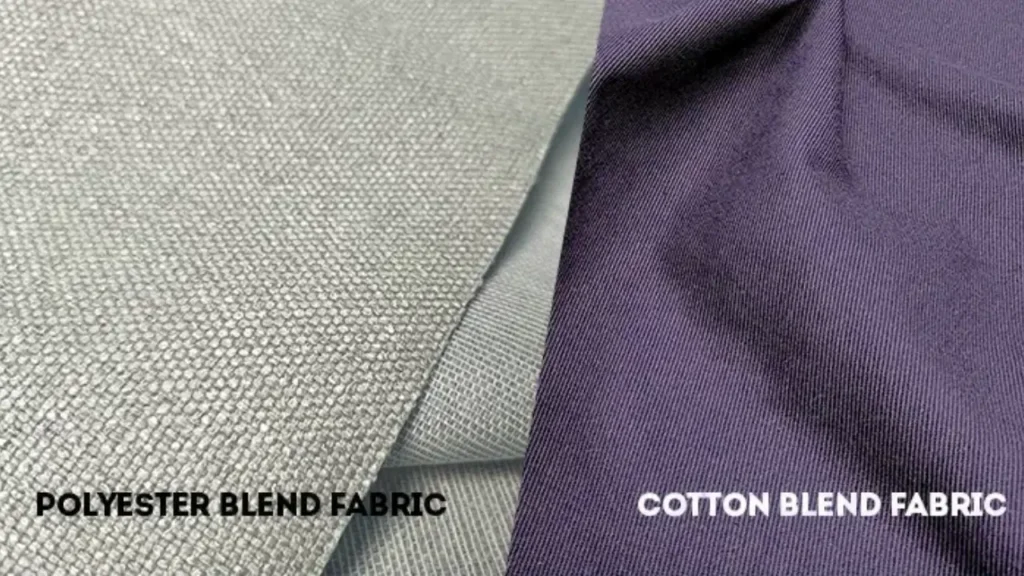
Understanding the differences between polyester fabric and cotton blends is essential for selecting the right material for various applications. Both have unique properties that cater to different needs and preferences.
Composition and Properties
Polyester fabric is a synthetic material made from petroleum-based polymers. It is known for its durability, wrinkle resistance, and quick-drying properties. Polyester fibers are strong and resilient, making the fabric resistant to stretching, shrinking, and abrasion. However, polyester is less breathable than natural fibers and can feel less comfortable in hot climates.
Cotton blends, on the other hand, combine cotton fibers with other materials, often polyester, to create a fabric that balances the properties of both. The blend aims to retain cotton’s comfort and breathability while enhancing its durability and wrinkle resistance. The ratio of cotton to polyester can vary, affecting the fabric’s overall characteristics. A higher cotton content provides more breathability, while a higher polyester content increases durability and wrinkle resistance.
Durability and Maintenance
Polyester fabric is highly durable and requires minimal maintenance. It resists shrinking, stretching, and fading, making it suitable for frequent washing and heavy use. Polyester’s quick-drying properties also make it ideal for activewear and outdoor clothing.
Cotton blends offer a balance of durability and comfort. The added polyester in these blends enhances the fabric’s strength and wrinkle resistance, making it more robust than pure cotton. However, the durability and maintenance requirements of cotton blends can vary depending on the blend ratio. Higher polyester content blends are typically more durable and easier to maintain than those with higher cotton content.
Comfort and Breathability
Polyester fabric, while durable, is less breathable than cotton. It can trap heat and moisture, leading to discomfort in hot or humid conditions. However, modern polyester fabrics are designed to improve breathability through advanced weaving and finishing techniques.
Cotton blends offer better breathability and comfort compared to pure polyester. The cotton component allows air to circulate, keeping the wearer cool and comfortable. The comfort level of a cotton blend depends on the ratio of cotton to polyester. Higher cotton content blends are more breathable and comfortable, while higher polyester content blends may feel less natural against the skin.
Cost and Environmental Impact
Polyester fabric is generally less expensive than cotton and cotton blends. Its lower production cost makes it a popular choice for mass-produced clothing and textiles. However, polyester is derived from petroleum and is not biodegradable, contributing to environmental concerns.
Cotton blends can vary in cost depending on the blend ratio and the quality of the fibers used. They are often more affordable than pure cotton but more expensive than pure polyester. While cotton is a natural and biodegradable fiber, the production of cotton blends with synthetic materials still contributes to environmental issues.
Comparison Table about the differences between polyester fabric and cotton blend fabric:
| Feature | Polyester Fabric | Cotton Blend Fabric |
| Composition | 100% synthetic (petroleum-based) | Combination of cotton and other fibers (often polyester) |
| Durability | High; resists shrinking, stretching, and fading | Moderate to high; enhanced durability compared to pure cotton |
| Maintenance | Easy; quick-drying and wrinkle-resistant | Moderate; varies depending on blend ratio |
| Comfort | Lower; less breathable, can trap heat | Moderate to high; better breathability than pure polyester |
| Breathability | Low; poor air circulation | Moderate; depends on cotton-to-polyester ratio |
| Wrinkle Resistance | High; excellent wrinkle resistance | Moderate to high; improved wrinkle resistance compared to pure cotton |
| Cost | Low to moderate | Moderate; varies depending on blend ratio and fiber quality |
| Environmental Impact | Non-biodegradable; contributes to environmental concerns | Varies; depends on synthetic fiber content; less eco-friendly than pure cotton |
| Applications | Activewear, outdoor clothing, upholstery | Everyday apparel, workwear, bedding |
How to Choose Blended Fabric and Cotton Fabric
Choosing between blended fabric and pure cotton requires a careful assessment of your specific needs and priorities. The ideal fabric depends on the intended application, desired properties, and personal preferences. Understanding the strengths and weaknesses of each option will help you make an informed decision that balances performance, comfort, and cost.
Here are key considerations when selecting between blended fabric and cotton fabric:
Intended Use and Durability:
Consider the fabric’s intended use and the level of durability required. For everyday apparel or items subjected to frequent washing, blended fabrics with synthetic fibers like polyester offer superior resilience. If comfort and natural feel are paramount, cotton is preferred, but blended fabrics with natural fibers like modal or rayon can also provide comfort with enhanced durability.
Comfort and Breathability Needs:
Evaluate your comfort preferences and the climate in which the fabric will be used. Cotton excels in breathability and comfort, making it ideal for warm climates and sensitive skin. Blended fabrics can offer varying levels of comfort; blends with high synthetic content may reduce breathability, while those with natural fibers can enhance softness and drape.
Maintenance and Care Requirements:
Assess your willingness to care for the fabric. Cotton requires careful washing to prevent shrinking and fading, while blended fabrics are generally easier to maintain. If convenience and minimal maintenance are essential, blended fabrics with wrinkle resistance and easy-care properties are preferable.
Cost and Environmental Impact:
Consider your budget and environmental concerns. Cotton can be more expensive, especially high-quality varieties, but it is biodegradable. Blended fabrics, particularly those with synthetic fibers, are often more affordable but contribute to environmental concerns. Evaluate the long-term cost and environmental impact when making your decision.
Aesthetic and Functional Properties:
Think about the desired aesthetic and functional properties, such as stretch, drape, or wrinkle resistance. Blended fabrics offer a wide range of tailored properties, allowing for specific performance characteristics. If a natural look and feel are desired, cotton is the best option.
Conclusion
Understanding the differences between blended fabrics and pure cotton is crucial for making informed textile choices. Blended fabrics offer enhanced durability, wrinkle resistance, and specialized properties, while cotton provides natural comfort and breathability. The ideal choice depends on specific needs, balancing performance and natural qualities.
Whether seeking the resilience of a cotton-polyester blend or the pure comfort of 100% cotton, the right fabric can significantly impact a garment’s longevity and feel. Explore the diverse range of high-quality blended fabrics at Fanda Fabrics. Contact us today to request a quote and discover the perfect blend for your textile requirements.
